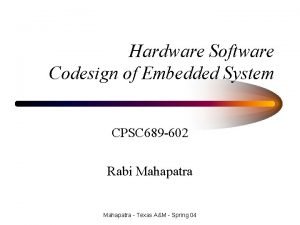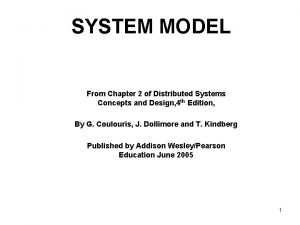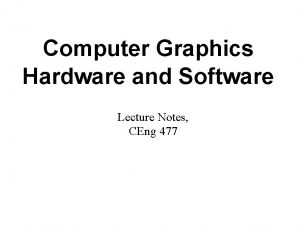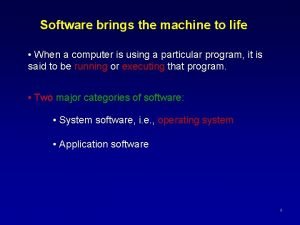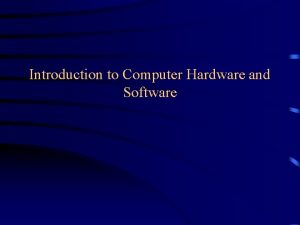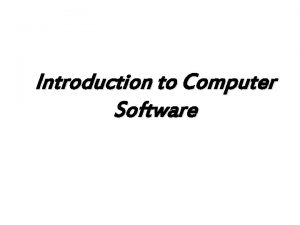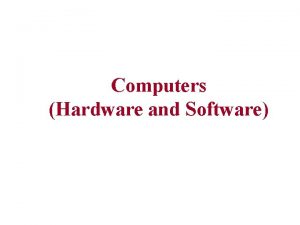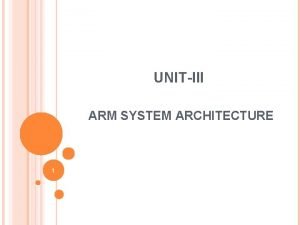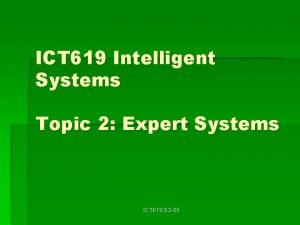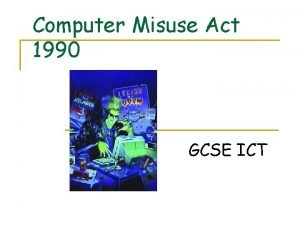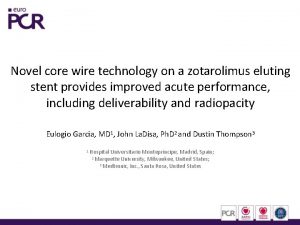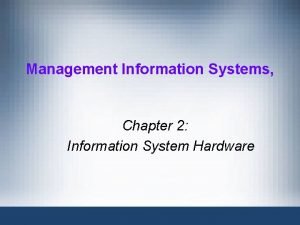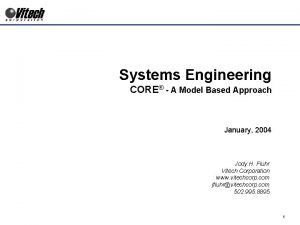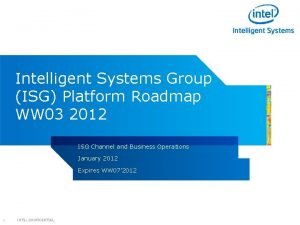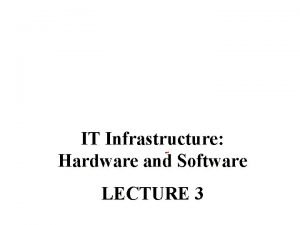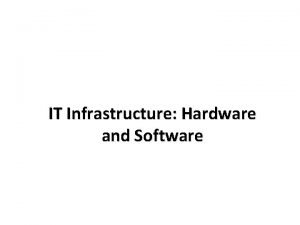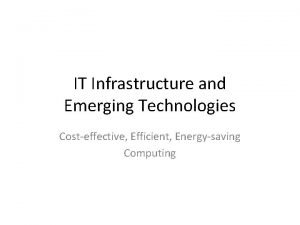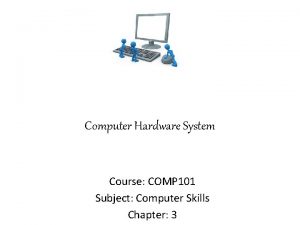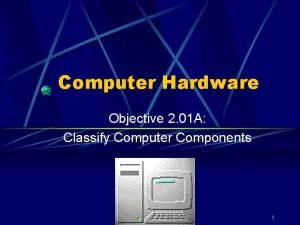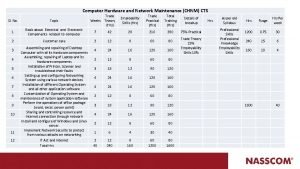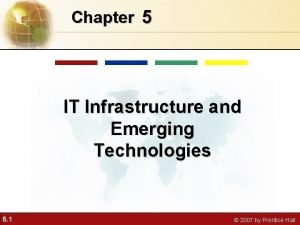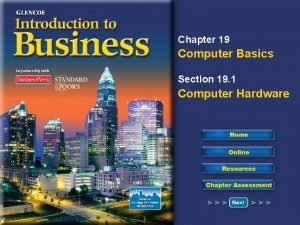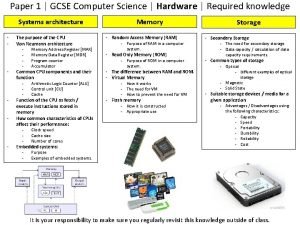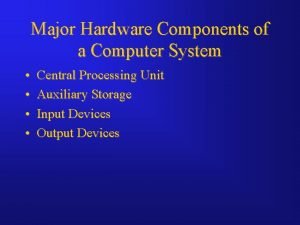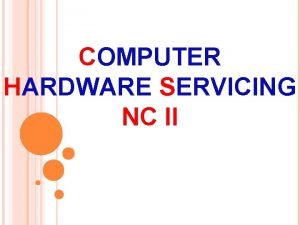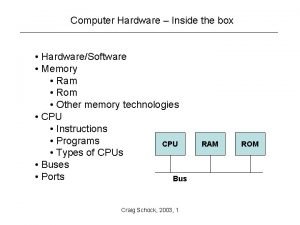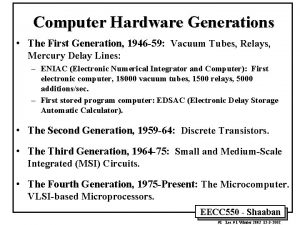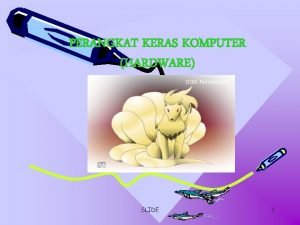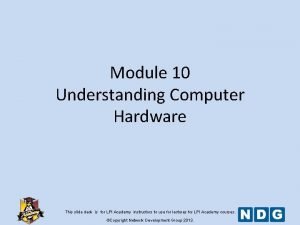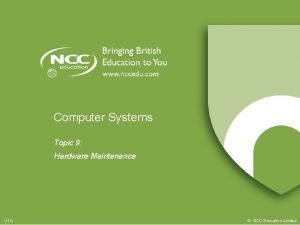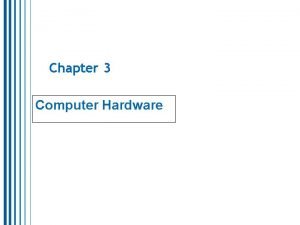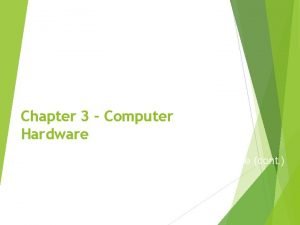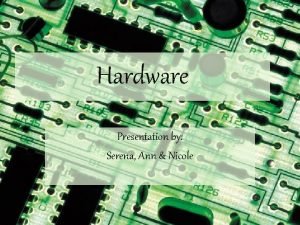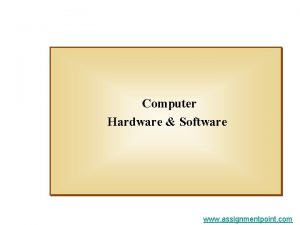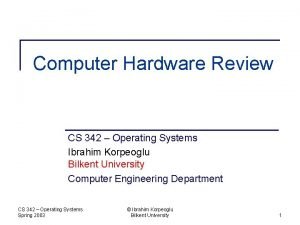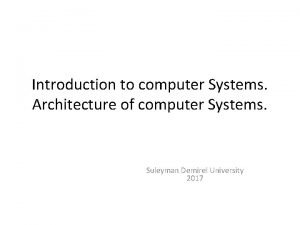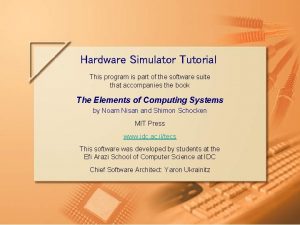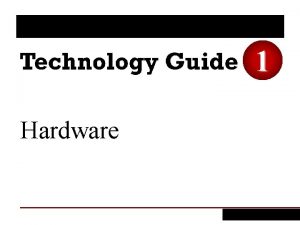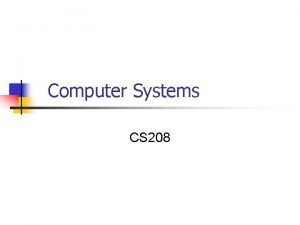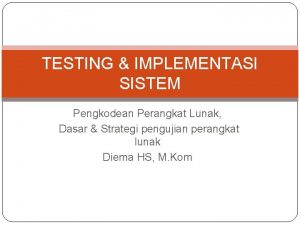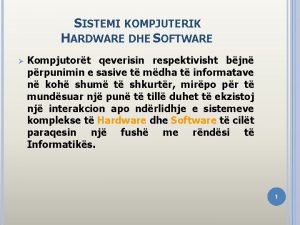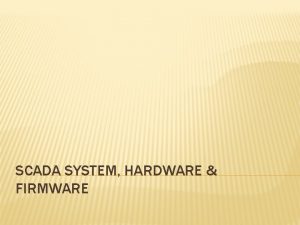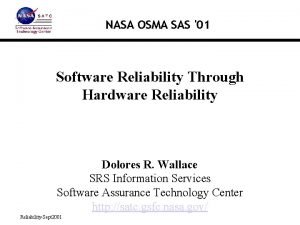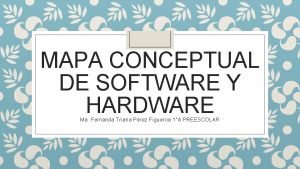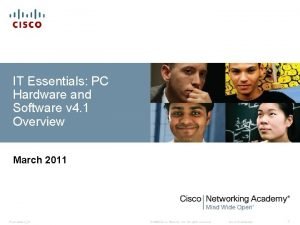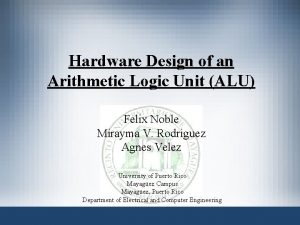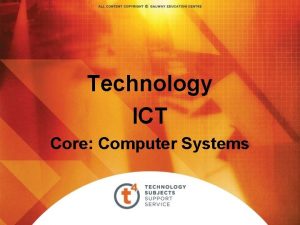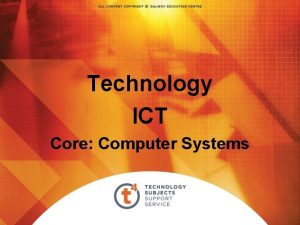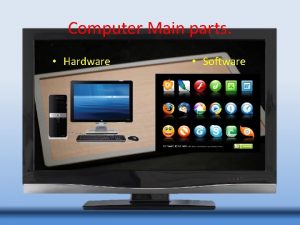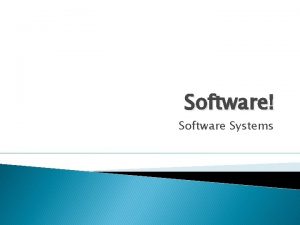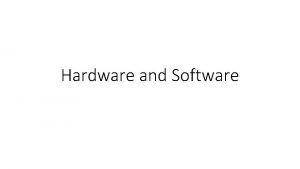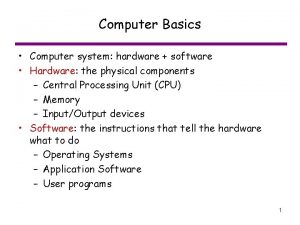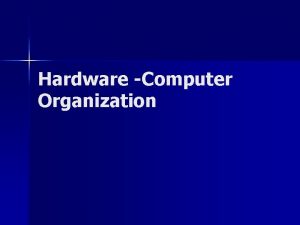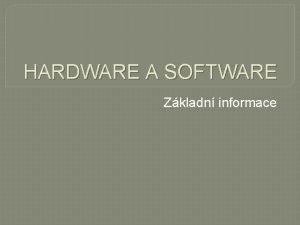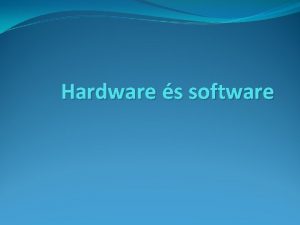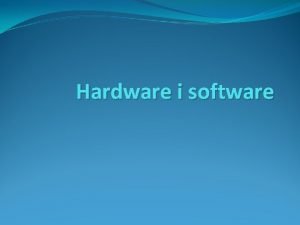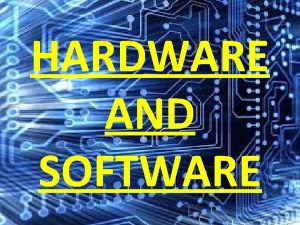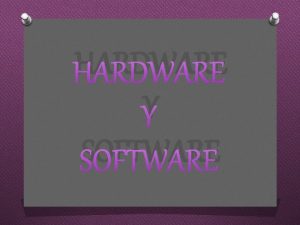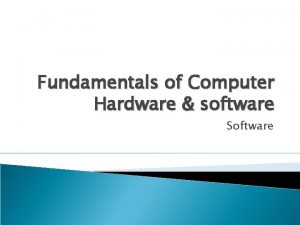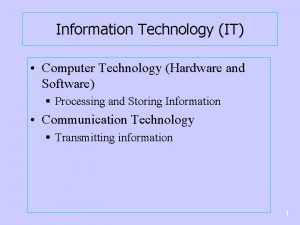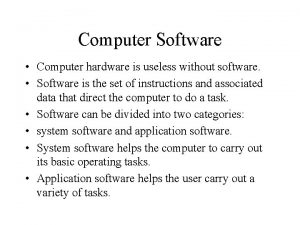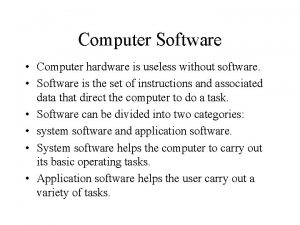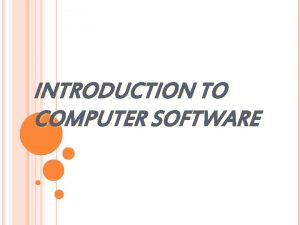Technology ICT Core Computer Systems Hardware Software Hardware

























































- Slides: 57

Technology ICT Core: Computer Systems

Hardware & Software Hardware All of the electronic and mechanical equipment in a computer is called the hardware. Examples include: • • • Motherboard Hard disk RAM Power supply Processor Case Monitor Keyboard Mouse

Hardware & Software The term software is used to describe computer programs that perform a task or tasks on a computer system. Software can be grouped as follows: • • • System software - Operating System etc. Utility programs - Antivirus etc. Applications Software - Word, Solid. Works etc.

PC Components Computer system - collection of electronic and mechanical devices operating as a unit. The main parts are: 1. 2. 3. 4. 5. System unit Monitor Keyboard Mouse Speakers 2 1 5 3 4

System Unit The system unit is the main container for system devices. It protects the delicate electronic and mechanical devices from damage. Typical system unit devices include: • • Motherboard CPU (Processor) Memory Disk drives Ports - USB etc. Power supply Expansion cards - sound card, network card, graphics card etc.

Peripherals are devices that connect to the system unit using cables or wireless technologies. Typical peripherals include: • • • Monitor Keyboard Printer Plotter Scanner Speakers Plotter

System Devices Processor An integrated circuit (IC) supplied on a single silicon chip. It’s function is to control all the computers functions. The main processor manufacturers are: • • AMD - Athlon and Turion (mobile) Intel - Pentium and Centrino (mobile) AMD Processor

System Devices Computer program - a series of instructions. When a program is run, the processor carries out these instructions in an orderly fashion. Typical instructions include: • • • Arithmetic - addition, subtraction etc Logical - comparing data and acting according to the result Move - move data from place to place within the computer system - memory to the processor for addition - memory to a printer or disk drive etc.

System Devices Processor speed - measured in megahertz (MHz) or Gigahertz (GHz) - the speed of the system clock (clock speed) within the processor and it controls how fast instructions are executed: • • 1 MHz - 1 million clock ticks every second 1 GHz - 1 billion clock ticks every second Latest trend - multi-core processors can have two, three or four processor cores on a single chip.

System Devices Random Access Memory (RAM) • Primary storage - main computer memory. Data, programs currently in use are held in RAM • Volatile - contents of memory are lost if the computer is turned off • Module - memory IC’s on a circuit board Memory Module IC’s

System Devices Memory is sold in modules: • DIMM’s (dual inline memory module) for desktop computers • SODIMM’s (small outline dual inline memory module) for notebook computers. DIMM Module SODIMM Module

System Devices DIMM’s and SODIMM’s are available in modules of 256 MB, 512 MB, 1 GB, 2 GB The current technology is called DDR (double data ram) and there are three types: DDR 1, DDR 2, DDR 3 Any particular computer system is only compatible with one type. Module capacity Module type Module name Module speed

System Devices Motherboard Mainboard or system board - the main circuit board for the computer system. All device in the computer system will either be part of the motherboard or connected to it. Memory Sockets Processor Socket Chipset PCI Slots Ports Graphics Slot

System Devices Processor socket - different processors require different sockets and a motherboard must be chosen to suit the processor intended for use: • • • Socket 478 - Intel Pentium IV Socket 775 - Intel Dual Core and Core Duo Socket 754 - AMD Athlon Socket 939 - AMD Athlon 64 Socket AM 2 - AMD Athlon X 2

System Devices Chipset - controls data flow around the computer. It consists of two chips: • • Northbridge - data flow between memory and processor - data flow between the processor and the graphic's card Southbridge - controls data flow to the devices - USB, IDE, SATA, LAN and Audio controls PCI slots and onboard graphics

System Devices Buses - a path through which data can be sent to the different parts of the computer system. Main buses: Processor Front Side Bus Northbridge Graphics Slot PC-Express or AGP Graphics Bus RAM Memory Bus All Memory Internal Bus Southbridge PCI Slots PCI Bus IDE SATA USB LAN Audio PCI Bus Onboard Graphics

System Devices Power Supply A computer power supply has a number of functions: • • Converts Alternating current (AC) Direct current (DC) Transforms mains voltage (240 Volts) to the voltages required by the computer. The main voltages are: • 12 volts for the disk drives as they have motors • 3. 3 and 5 volts for the circuit boards in the computer

System Devices • Uses advances power management (APM) to allow the computer go into a standby mode • Some have a switch to toggle between 240 volt supplies and 110 volt supplies. • The main connections are: 3 1 4 2 1 Main connector Connects to the motherboard and supplies the 3. 3 and 5 volt supply for the board. 2 Molex connector Connects IDE hard drives and optical drives. 3 Berg connector Connects floppy disk drives 4 SATA connector Connects SATA drives

System Devices Ports Computer ports are interfaces between peripheral devices and the computer. They are mainly found at the back of the computer but are often also built into the front of the computer chassis for easy access. Ports at the rear of the computer Ports at the front of the computer

System Devices • Serial port - a 9 -pin port. Often called Com ports - Com 1, Com 2 etc. Mice and external modems were connected to these ports. They are turquoise in colour. • Parallel port - a 25 -pin port used to connect printers, scanners, external hard disks, zip drives etc. to the computer. Burgundy in colour, they are often called LPT ports LPT 1, LPT 2 etc.

System Devices • Video port - used to connect a monitor to the computer system. There are two types: • VGA port - This is a 15 -pin port and is blue in colour. It is an analogue port and is being replaced by the DVI port. • DVI port - white in colour, it is a digital port. This means that no conversion is necessary between the computer and the monitor and that means that images can be produced more quickly on the monitor

System Devices • PS/2 port - used to connect keyboards and mice to the computer. The keyboard port is purple and the mouse port is green • Modem port - used to connect a modem to a telephone line. RJ 11 is the technical term for the port.

System Devices • USB port - intended to replace Serial, Parallel and PS/2 ports with a single standard. 127 devices can be connected to a single USB port. Hot swappable - devices can be connected and disconnected while the computer is on There are different USB standards in use: • USB 1 - original standard - transfer data of 1. 5 MBps. • USB 2 - current standard - transfer rate of 60 MBps. • USB 3 - future standard (2009) transfer rate of 600 MBps.

System Devices • Fire. Wire port - (IEEE 1394) is an Apple technology There are two versions available and a third is planned: • • • FW 400 - transfer rate of 50 MBps. FW 800 - transfer rate of 100 MBps. FW S 3200 - transfer rate of 400 MBps. • USB devices must be connected to a host computer while Fire. Wire devices can be connected to each other without using a computer.

System Devices • Ethernet port - used to connect to a network. Known as RJ 45, it is larger than a modem port. • Audio ports - used to input and output audio from the computer. Three mini jack ports but there may be more: • • • Light blue - Line in - connect external devices Lime - Connect the speakers to this port. Pink - Connect a microphone to this port.

System Devices Graphics card 3 1 4 2 5 1 Processor and fan Graphics card handles it’s own processing making it almost independent of the processor. 2 Board connector AGP or PCI-Express 3 Memory Graphics card has it’s own memory. This makes it much faster. Most new cards use DDR 3 memory. 4 DVI connector Digital output is supplied through this port. 5 VGA connector Analogue output is provided through this port.

System Devices Graphic card - screen images are made up of dots called pixels (picture elements). The graphics card must process each of these pixels to create the image. The resolution of a screen is the number of pixels being displayed. Typical resolutions include: • • 800 x 600 1024 x 768 1280 x 1024: 1600 x 1200: - 480, 000 pixels 786, 432 pixels 1, 310, 720 pixels 1, 920, 000 pixels

System Devices There are two types of graphic card available: • AGP (accelerated graphics port) - the older technology but still available. It can output in analogue or digital or both. • PCI-Express - the newer technology - faster than AGP. Allows for two graphics cards to improve the performance - called Scalable Link Interface (SLI). PCI-Express can also output in analogue or digital or both. • These cards are mutually exclusive and the choice is made according to the graphics slot on the motherboard.

System Devices Sound card 1 2 3 1 PCI connector Connects the sound card to a PCI slot 2 MIDI socket Musical Instrument Digital Interface port is used to connect digital musical instruments to the computer. 3 Audio jacks These are used to connect microphones, speakers, stereo systems etc to the computer.

System Devices The main functions of a sound card are: • To use a DAC (digital to analogue converter) to prepare audio for speakers etc. • To use an ADC (analogue to digital converter) to convert the audio coming into the computer. A sound card can be connected to the following: • • • Analogue input devices - Microphone, Radio, Tape deck, Record player etc Headphones and speakers Output to tape etc.

System Devices Network card • allows computers join a network. Can be wired or wireless. The standard used is called Ethernet - covers wired and wireless networks. The wired standards include: • • Fast Ethernet - transmission speed of 100 Mbps. Gigabyte Ethernet - transmission speed of 1000 Mbps. PCI PC card USB

System Devices The wireless standards include: • • • The B standard - introduced in 1999, it has a transmission rate of 11 Mbps and a range of 30 Metres. The G standard - introduced in 2003, it has a transmission rate of 54 Mbps and a range of 30 Metres. The N standard - introduced in 2006, it has a transmission speed of 540 Mbps and a range of 50 metres. PCI PC Card USB

System Devices Modem • • Internet access using a telephone line. Converts the digital computer data to analogue (Modulation) before transmission over the telephone line and converts the analogue data to digital (DEModulation) before transmission to the computer. The device gets it’s name from these two terms. • The standard transmission speed of a modem is 56 Kbps. PCI USB

System Devices Hard Disk • Primary storage (memory) - volatile - contents lost when power is turned off. • Secondary storage (disk drives) - non-volatile can store files when power is turned off. • In memory, voltages are used to store data as binary 1’s and binary 0’s. It was decided to mimic the situation for secondary storage using magnetism instead of electrical voltages to represent the binary data.

System Devices • A metal disk (platter) is coated with tiny iron particles which can be magnetised to north and south to represent the binary digits 0 and 1. • A read-write head is used to magnetise the particles on the disk surface to represent the data held in RAM. The computer can now be switched off and a copy of the data is safe for later use. Metal disk (platter) covered with iron particles. Read-write head

System Devices Hard disks can be internal or external. The internal standards are: • IDE ( Integrated Drive Electronics). The disks connect to the motherboard using a ribbon cable. Each cable can hold two drives - master and slave. The drive is set as master or slave by positioning a jumper switch on the back of the drive. There are two IDE connectors and a total of four drives can be connected. Master Slave M/board Jumper

System Devices • SATA (Serial Advanced Technology Attachment) allow faster data transfer speeds than IDE. There is no master/slave arrangement with SATA and each drive has it’s own cable. The cables are much smaller and allow better air circulation in the system unit. SATA Cable Motherboard connectors IDE SATA

System Devices External hard disk drives can be IDE or SATA and can be mains powered or host powered. Host powered drives receive their power from the USB port. Mains Powered Host Powered Hard disk drives are also now found in video recorders, digital music players, digital camcorders, digital cameras and mobile phones. 2½ inch Notebook Drive 1 inch Microdrive

System Devices Optical drives • Optical drives use lasers to sense pits and lands mechanically pressed into a polycarbonate disk. These pits and lands represent the binary 0’s and 1’s and so can store computer data. • A thin layer of metal reflect the laser light. As the disk rotates, the laser senses the pits and lands and reads the data from the disk. The laser only operates at a single intensity as it only scans the surface of the disk to detect the pits and lands. Land Pit

System Devices CD-R (blank CD’s) use a dye layer to mimic the lands and pits created mechanically on commercial disks. • • • The laser used has two intensities. At the high setting, it burns spots on the dye layer changing it from transparent to opaque. This allows data to be written as spots of transparency and opacity. At the low setting, it reads these differences Label Reflective metal layer Polycarbonate Dye layer

System Devices The CD-RW (re-writable) disk is similar but the laser has three intensities. The third and highest is needed to turn the burned areas of the dye layer back to their original condition. The dye layer can now be re-burned to hold new data. The three laser intensities are: • • • Intensity 1 Intensity 2 Intensity 3 - Read data Burn data Erase data The CD-R disk has a capacity of 650 MB to 800 MB.

System Devices DVD’s hold a lot more data than CD’s. They can have several layers, each holding 4. 7 GB of data. The possibilities are: Number of sides 1 1 2 2 Number of layers 1 2 Disk capacity 4. 7 GB 8. 5 GB 9. 4 GB 17 GB Dual layer disks have two reflective layers, one which can be penetrated at a certain intensity Label Total reflective metal layer Dye layers Semi reflective metal layer Polycarbonate

System Devices DVD Formats Read only. Mechanically stamped and manufactured as single or double layer and as single sided or double sided. 1 DVD-ROM 2 DVD-R 3 DVD-RW 4 DVD+R These are single or dual layer disks and can be single or double sided. They can be written to only once. 5 DVD+RW These are the same as DVD+R only that they can be written to several times. Single or dual layer disks and can be single or double sided. They can be written to only once. Same as DVD-R but can be written to several times. DVD-R and DVD+R are incompatible with each other. Manufacturers have produced DVD±R drives capable of reading and writing to both standards.

System Devices A number of new high capacity formats have come onto the market. These are: 1 2 HD-DVD Uses a new laser technology resulting in layer of 15 GB instead of the 4. 7 GB on standard DVD. This gives a total capacity of a double sided - double layered disk as 60 GB. Blu-Ray Higher capacity than HD-DVD - 25 GB of data/layer. A dual layer disk can hold 50 GB. Technically, a double sided and double layered disk can hold 100 GB of data. Blu-Ray HD-DVD

System Devices Card readers Replaces floppy drives in new computers. They can read media cards from most digital cameras: • • • Microdrive: Smartmedia: SD memory card: Memory stick/Duo/Pro: x. D picture card: Card reader drive

System Devices Monitors A computer monitor displays images generated by the graphics card. Monitors are almost exclusively LCD (Liquid Crystal Display). CRT (Cathode Ray Tube) monitors are rare and are now as expensive as LCD monitors. 19 inch Widescreen LCD

System Devices The aspect ratio of a computer monitor is the ratio between the width and height of the screen. The aspect ratios are: • • Standard monitor Widescreen monitor - 4: 3 16: 9 Most LCD monitors offer a VGA and a DVI connection. The VGA connector is used for analogue signals and the DVI connector is used for digital. As the computer is a digital machine, it is best if no conversion is required and so the best option is the DVI connection. DVI VGA

System Devices Resolution Standard monitor • • XGA (Extended Graphics Array) - 1024 x 768 SXGA (Super Extended Graphics Array) - 1280 x 1024 UXGA (Ultra Extended Graphics Array) - 1600 x 1200 QXGA (Quad Extended Graphics Array) - 2048 x 1536 Widescreen • • • WXGA (Wide XGA) - 1280 x 800 WSXGA (Wide SXGA) - 1680 x 1050 WUXGA (Wide UXGA) - 1920 x 1200 LCD monitors - native resolution at which the image is crisp. Other resolutions are possible but the image quality decreases.

System Devices Keyboard Primary input device - divided into sections: • Typing keys - contains the letter and number keys, shift keys, spacebar, return key etc. • Numeric keypad - These keys are arranged as on a calculator. • Function keys - programmable keys used by software for special functions. E. g. - F 1 - Help. • Control keys - screen and cursor control.

System Devices • • Most common arrangement is called QWERTY after the first six keys. Other arrangements are available including Dvorak, ABCDEF, AZERTY etc. QWERTY Dvorak

System Devices Keyboards are available wired or wireless: • • Wired - These are either PS/2 or USB. Wireless - The keyboard uses batteries. Wireless keyboard Rubber keyboard - useful for use with notebook computers. Leaves users less prone to RSI (Repetitive Strain Injury)

System Devices Mouse Input device - uses point and click technology There are two main types: • Ball mouse - uses a ball to roll across the surface and move rollers attached to sensors inside the mouse - reflecting the ball movement as cursor movement. • Optical mouse - camera takes thousands of images per second and sends them for digital processing. The red LED lights up the surface for the camera. Ball mouse Optical mouse

System Devices Printers Output devices - produce a hardcopy ( permanent and readable) of computer data. The can print onto paper, transparency, photographic paper, card etc. There are two main technologies involved: • • Inkjet (Bubble-jet) Laser

System Devices • Inkjet - uses an electric charge to vibrate a membrane. When the membrane flexes downwards, it ejects an ink droplet through the nozzle (1). When it flexes upwards, it draws more ink into the reservoir (2). 1 • 2 Bubblejet - a heating element locally heats ink to form a bubble (1). As the bubble expands, it forces ink through the nozzle (2). When it bursts, it causes a vacuum which draws ink into the reservoir (3). 1 2 3

System Devices Laser printers use toner (powdered ink) instead of liquid ink as in inkjet printers. • Laser printers produce images using dots. The image is created using a laser beam and a mirror -lens arrangement on a drum coated with magnetically charged toner and then transferred from the drum to the paper. The paper is then fed through a heated fuser which fuses the toner to the paper as ink. Laser Toner Fuser Drum Mirror and lens

System Devices Printers are available as A 4, A 3 and even A 2, but if larger drawings and images are required, a plotter is more suitable. Plotters use inkjet technology and are available in A 3, A 2, A 1 and A 0. They take up much less space than an equivalent inkjet or laser, bur are more expensive. Plotter

System Devices Computer Specification • • • • Intel Core Duo Processor - 2. 66 MHz 64 -Bit CPU, 128 KB L 1 cache, 4 MB L 2 Cache, 1333 MHz FSB Windows Vista Business 4 GB DDR 2 Memory - 667 MHz 500 GB SATA HDD 10, 000 rpm 256 MB DDR 2 NVIDIA PCI-Express Graphics 19" Widescreen LCD - 0. 22 mm Dot Pitch, Res -1490 x 900 7: 1 Surround Sound Inc. Woofer PCI-E Mainboard - n. Force SLI, Micro ATX 6 x USB 2 Ports - 2 Front 2 x 1394 Ports - 1 Front Broadcom GB LAN Network Connection Multi Card Reader 18 X SATA Dual Format Dual Layer DVDRW Drive 550 W Power Supply Logitech Wireless Internet Keyboard and Wireless Optical Mouse
 Hardware software codesign in embedded systems
Hardware software codesign in embedded systems Interaction model in distributed system
Interaction model in distributed system Computer graphics hardware and software
Computer graphics hardware and software Software brings computer hardware life how
Software brings computer hardware life how Hardware and software introduction
Hardware and software introduction Hardware introduction
Hardware introduction Four major data processing functions of a computer
Four major data processing functions of a computer External hardware components
External hardware components Risc design philosophy
Risc design philosophy Expert systems ict
Expert systems ict The brittle, rocky outer layer of earth
The brittle, rocky outer layer of earth The crust the mantle and the core
The crust the mantle and the core Crust outer core inner core mantle
Crust outer core inner core mantle Core capabilities and core rigidities
Core capabilities and core rigidities Scanners produce text and graphics on a physical medium
Scanners produce text and graphics on a physical medium Teach ict computer misuse act
Teach ict computer misuse act Hardware technology trends
Hardware technology trends Core wire technology
Core wire technology Fluid core technology examples
Fluid core technology examples Hardware in information system
Hardware in information system Coresim
Coresim Core concepts of accounting information systems
Core concepts of accounting information systems Intel platform roadmap
Intel platform roadmap Computer hardware platforms in it infrastructure
Computer hardware platforms in it infrastructure Computer hardware platforms in it infrastructure
Computer hardware platforms in it infrastructure Computer hardware platforms in it infrastructure
Computer hardware platforms in it infrastructure Computer arithmetic: algorithms and hardware designs
Computer arithmetic: algorithms and hardware designs Computer hardware 101
Computer hardware 101 Computer hardware classification
Computer hardware classification Computer hardware & network maintenance
Computer hardware & network maintenance Chapter 5 it infrastructure and emerging technologies
Chapter 5 it infrastructure and emerging technologies Graphic organizer of computer hardware
Graphic organizer of computer hardware Hardware gcse computer science
Hardware gcse computer science Parts of computer
Parts of computer Computer hardware servicing nc2
Computer hardware servicing nc2 Access memory
Access memory First generation evolution of hardware
First generation evolution of hardware Mengidentifikasi berbagai komponen perangkat keras komputer
Mengidentifikasi berbagai komponen perangkat keras komputer Computer hardware slides
Computer hardware slides Introduction to computer graphics - ppt
Introduction to computer graphics - ppt Hardware topic
Hardware topic Secondary storage device
Secondary storage device 3 computer hardware components
3 computer hardware components Computer hardware slides
Computer hardware slides Objectives of computer hardware
Objectives of computer hardware Computer hardware review in operating system
Computer hardware review in operating system Functions of system unit
Functions of system unit Computer hardware simulator
Computer hardware simulator Major hardware components of a computer system
Major hardware components of a computer system What are the core components of a computer system
What are the core components of a computer system Testing dikatakan baik, jika
Testing dikatakan baik, jika Hardware and software shqip
Hardware and software shqip Scada is a software or hardware
Scada is a software or hardware Diffrence between hardware and software
Diffrence between hardware and software Mapa conceptual de hardware y software
Mapa conceptual de hardware y software Cisco it essentials virtual desktop download free
Cisco it essentials virtual desktop download free Hardware dan software jaringan komputer
Hardware dan software jaringan komputer Alu hardware or software
Alu hardware or software
